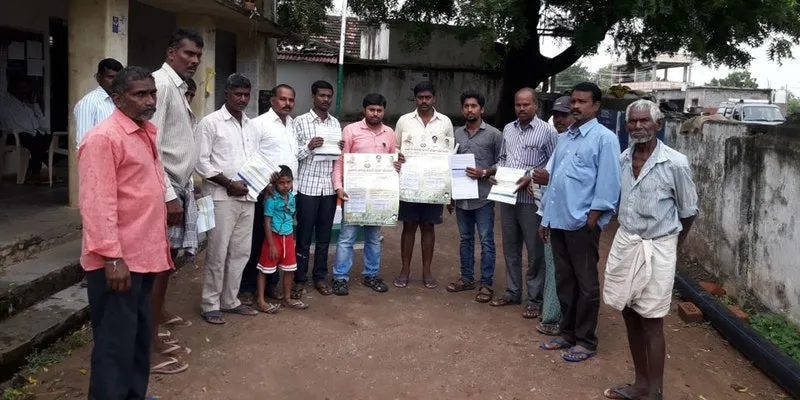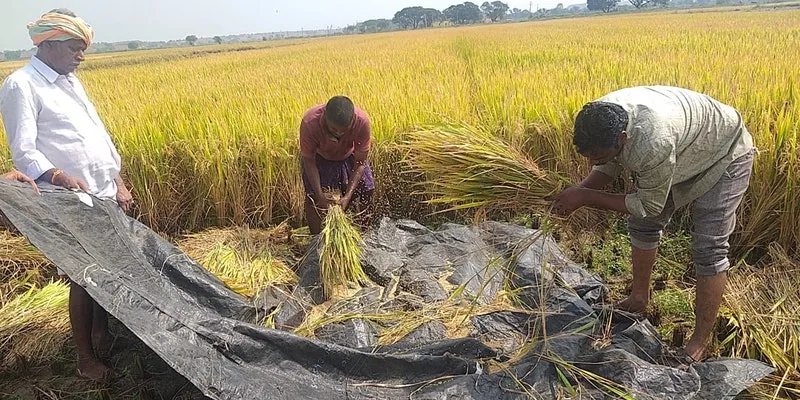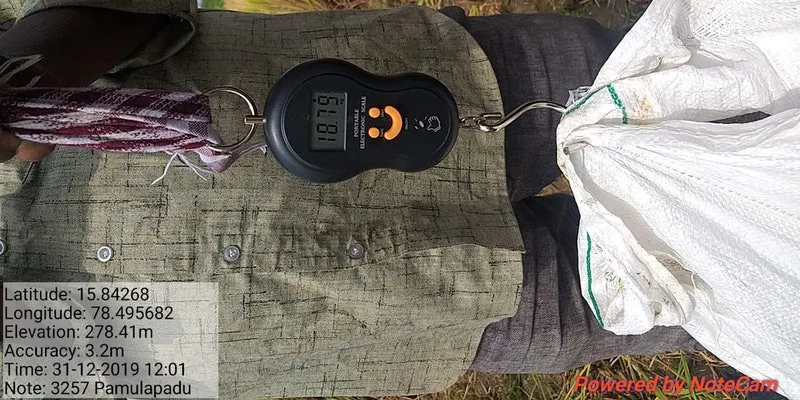Started by former NASA Earth scientists, Hyderabad-based Niruthi is solving India’s farming issue
Niruthi provides field-level information needed by farmers to better manage their crops. Currently, it serves over one million farmers and over 20 million hectares of croplands.
Post the Cold War era, space has become a focus area for developed countries like the US, Russia, and China. Since the 60s, these countries have been spending billions of dollars on sending satellites and manned missions to the Moon, to demonstrate their power and capabilities.
India too has joined the league by sending satellites and using space-based applications to gather climate-related data to help farmers with weather-related information. And, joining the bandwagon is Hyderabad-based agritech startup Niruthi, which offers solutions for monitoring, modelling, and forecasting crop conditions through location-specific weather, crop health, and crop yields across India.

CTO Cristina Milesi and CEO Malikarjun Kunkunuri, Niruthi
Founded in 2011 by Dr. Cristina Milesi, a former Earth scientist at NASA, and her colleagues, Niruthi provides field-level information needed by farmers to better manage their crops.
The startup has also deployed its technology to support the crop insurance industry in India as well as in Vietnam, covering a variety of crops, including soybean, rice, bajra, jowar, gram, cotton, and wheat, and climatic conditions – serving over one million farmers over 20 million hectares of croplands.
The beginning
It all started when she was working in NASA as Earth scientist, where she used satellite data to monitor and predict global ecosystems with a focus on agriculture, forestry, and urban systems.
While working on tools such as the Terrestrial Observation and Prediction System (TOPS) to study earth’s ecosystems, she realized that with some tweaks, the same technology could be used to solve problems faced by farmers in countries like India, where farming is dependent on the monsoon.

Niruthi beneficiaries
In 2010, the Government of India was working with various data points related to agriculture like location-specific weather and historical crop yields to assess the basic risk and bring appropriate policies related to the sector. And, the startup’s solution was ideal to address the problems faced by the crop insurance industry.
With initial funding from global re-insurance company SwissRe, in 2011, the former scientists launched Niruthi in India to adapt TOPS, and design local solutions for the Indian market.
“While working at NASA, our research in climate change and its impact on agriculture led us to believe that the key ways to mitigate the risk of farming from climatic changes were to provide irrigation to crops and crop insurance to farmers,” Cristina says.
The solution
Niruthi aggregates data from multiple sources, including satellites, drones, weather stations, Internet of Things (IoT), as well as farm-level data through mobile apps for machine learning (ML) to detect anomalies, and forecast crop yields that can be displayed in a visualisation dashboard and accessed via APIs.
Its data-to-decision analytical tool serves the insurance industry in various ways in their business.
“One of the key requirements for increasing access to crop insurance as well as improving crop productivity is the information about local weather conditions and forecasts that allow insurers to assess the basic risk, and for farmers to react to changing weather conditions,” Mallikarjun Kukunuri, CEO, Niruthi, says.
The startup provides local weather information from well-maintained weather stations by observing the data from solar radiation, rainfall, and humidity received from the satellites. Niruthi demonstrated the technology in Maharashtra, which suffers from drought conditions, by creating village-level daily weather forecasts for over 40,000 villages using information from four satellites and 300 weather stations.
According to the team, the startup has access to all open-source satellite data from Landsat, Sentinel-2, Terra, and Aqua, among others. “We use commercial data from platforms such as Planet Labs, only when needed by our clients to produce hyperlocal information on crop losses,” Cristina says.
On an average, Niruthi processes about 10TB of daily satellite data, about 500GB of climate data, and over 100TB of CropSnap images per season in India.
Addressing the farmer issue
Various governments and agencies use data from satellites to provide information for crop classification, crop monitoring, and crop yield estimation.
Niruthi’s solution uses this data to predict crop yields required for insurance claims, for government agencies to decide the minimum support price (MSP) for crops, and to assess food security.
Mallikarjun adds, “Back in the day, crop yields were estimated by using crop cutting experiments, which, in today’s world, are highly unreliable because of the complexity in conducting such experiments, and they are prone to manipulation.”
To address these concerns, Niruthi uses its technology in two ways. First, it uses its intelligent sampling method where it chooses the number and locations of crop-cutting experiments through the analysis of crop-yield modelling from satellite data and local weather information.
Second, by assimilating crop yield data from the well-chosen set of crops-cutting experiments and scaling the results to larger areas using satellite-derived crop yields.

For the insurance industry, it assesses the risk of a given combination of crop or region by helping the industry in bidding for State government contracts for crop insurance for the region or crop-based risk for the upcoming season, farmer enrollment in the insurance schemes, and claiming settlements via CropSnap and Niruthi’s AI-based app by self-reporting with yield estimates by photo.
Niruthi's API services provide continuous crop assessments and advisories derived from its data-model assimilation system, as well as creates insurer’s risk profiles by analysing long-term historical climate and satellite data.
“The main problem that we face is the lack of reliable data, as well as access to government data sets that are crucial for implementing farm-level solutions. It took us several years to collect data and build appropriate models that can estimate crop yields,” Cristina adds.
To help stakeholders, Niruthi uses sophisticated algorithms that convert satellite data into measures of leaf area index and a fraction of absorbed radiation that is bio-physically meaningful. It is then integrated with daily climate data to model crop photosynthesis, which translates to crop growth.

Further, it converts photosynthesis accumulated over the season to crop yields using the crop variety and an estimate of harvest index (amount of photosynthesis converted to yield), which is further calibrated with CropSnap images to estimate crop yields at the field level.
Using its data intelligence, Niruthi also provides insurers with loss forecasts, yield estimation, and smart sampling schemes to identify geographies for insurers to conduct their field surveys reliably and affordably.
“We also provide layers of agronomic and weather intelligence to support farm risk management through farmer specific recommendations on when to fertilise, irrigate, and apply pesticides based on the local agronomic conditions and weather data,” Cristina says.
The market, the team, and the future ahead
Since 2011, the crop insurance premium market has grown from about $500 million to $4 billion.
“With the Prime Minister’s emphasis on farming and his interest in doubling the farmer’s income by 2022, there is a tremendous potential for age-related services. For example, currently, crop insurance covers only 20 percent of the cropped area in India. The government wants to raise this number to 50 percent by 2022.”
The agritech startup has received an award from the World Bank for its technology. It has also been awarded the Best Data Analytics Company. In July 2019, the agritech startup had received an award from the World Bank for Best Data Analytics Company from among 105 companies from 21 countries.
At present, Niruthi has a team of few advisors, which includes Dr. YS Rama Krishna, former Director ICAR – CRIDA and Apex Committee Member for NDMA, Government of India; Dr. M Satya Kumar, former Director at IMD Hyderabad; and Dr. G Srinivasan of RIMES.
Speaking on what drives Niruthi, Cristina says,
“We want to bring all the stakeholders under one umbrella, and maintain synergy in the data so that the last mile gets benefited. Niruthi’s customers are crop insurance companies, crop commodity companies, governments, and financial institutions.”
(Edited by Suman Singh)








